4 SaaS Financing Options to Help Growth-Stage B2B Startups Scale Smarter
| TL;DR - Raising a Series A isn’t the end of your funding story—it’s the beginning of a new one. Once you’re scaling your business, the capital that helped you prove PMF (Product-Market Fit) often falls short. This post breaks down four smarter SaaS financing options for growth-stage B2B startups and why quote-to-cash with embedded financing may be the most scalable of all. |
The Challenge: Most SaaS founders think Series A solves their capital problem—until they start scaling.
You’ve raised Series A. It got you to product-market fit, a lean Go-To-Market (GTM) engine, and your first wave of customers.
But now you’re scaling the business—and though you’re growing fast, you’re burning even faster.
Here’s why:
📈 Customer Acquisition Cost (CAC) rises before payback
🕒 Enterprise buyers delay payments (net-60, net-90)
💸 You’re funding longer sales cycles, bigger teams, and complex GTM—before cash hits your account
Series B may be months away, and raising more equity too soon means giving up more than you should.
To scale smarter, growth-stage B2B SaaS companies need capital that aligns with sales velocity, protects equity, and accelerates GTM.
In this post, we’ll explore four promising SaaS financing options—and why Quote-to-Cash (Q2C) with embedded financing by Ratio may be the most scalable, sales-aligned model of all.
Four SaaS Financing Options Built for Scaling B2B Startups
We recently broke down the short-term financing options B2B SaaS companies use to unlock quick capital. But at scale, it's not enough as you need more than a cash patch—you need a financing strategy that keeps up with your sales motion.
So what are your options?
Here are four capital sources every scaling SaaS team should have on their radar:
- Quote-to-Cash (Q2C) with Embedded Financing
- Contract-Based Advances
- Larger Revenue-Based Financing (RBF)
- SaaS-Specific Term Loans (via fintech lenders)
👇 Let’s explore what makes each one useful—and where the trade-offs start to show.
#1. Quote-to-Cash (Q2C) with Embedded Financing
Q2C with embedded financing is a non-dilutive SaaS financing option that helps growth-stage B2B SaaS companies get paid upfront for annual or multi-year contracts—without changing their pricing model or chasing payments.
This model embeds financing options like Buy Now, Pay Later (BNPL) directly into your sales motion meaning capital access to sellers and flexible payments to buyers are offered at the point of quoting, not bolted on later.
Instead of asking customers to pay the full amount upfront—or waiting 12 months to collect it—this model allows a third-party provider (like Ratio Boost) to pay sellers the entire contract value within days of the deal closing. The buyers then pay as per their terms.
📌 Example: You close a $72K annual SaaS deal. The buyer chooses to pay $6K/month. You receive $69,120 upfront (after a 4% fee), while Ratio handles collections.
🚀How It Supports SaaS Scaling
Q2C with embedded financing isn’t just a cash flow fix—it’s a GTM growth lever designed for scale:
- 💸 Instant cash for every closed deal
Get paid upfront on annual contracts—without discounts, delays, or Day Sales Outstanding (DSO) friction. That means more working capital right when you need it to fuel GTM.

- 🧠 Preserve equity, skip debt
Embedded financing is a non-dilutive and off-balance sheet. No repayments. No covenants. Just cash in and clean books—so you can grow without giving up ownership or taking on loan obligations. - ⚡ Accelerate GTM motion without discounting
Close high-value SaaS deals annually without lowering prices or offering discounts. Instead, buyers pay monthly as per their terms, and you collect full value. That compresses your sales cycle without sacrificing margin.
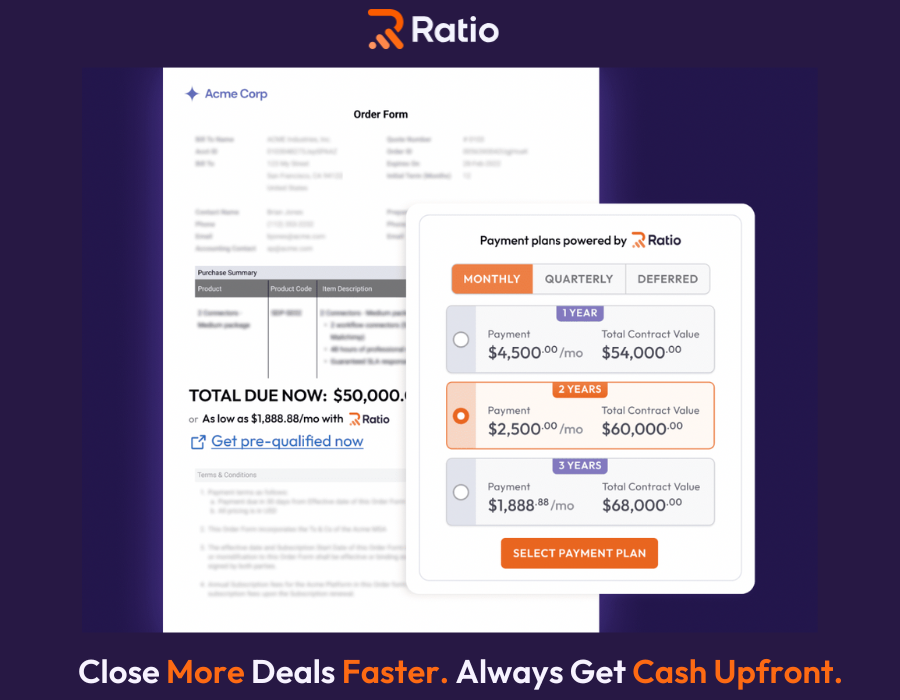
- 🧾 Reduce enterprise payment friction
Skip procurement delays and CFO roadblocks. Flexible payment terms mean fewer lost deals, faster closes, and greater buyer satisfaction.
- 🔁 Recycle capital faster
Reinvest into CAC-heavy channels or team expansion immediately—rather than waiting 12 months for cash that’s already earned.
🔍How to Access It
We recommend first exploring what a broken Quote-to-Cash (Q2C) workflow looks like—or the key signs to watch for—as outlined in our blog post, Broken Quote-to-Cash? How to Fix It to Unlock SaaS Growth.
There are several providers of embedded financing in the market today—but few are built specifically for B2B SaaS, and even fewer integrate into the full Q2C workflow.
Once you've found the right fit (like Ratio), here’s what a best-in-class experience looks like:
1️⃣ Launch from your CRM
Access Ratio directly from Salesforce, HubSpot, or CPQ—no new tools.
2️⃣ Select or add buyer
Auto-pull info from CRM. Ratio pre-fills EIN and details for underwriting.
3️⃣ Configure plan + fees
Offer 12/24/36-month terms; decide how fees are split. The buyer sees their options in real-time.
4️⃣ Submit for instant approval
Ratio underwrites most buyers in seconds—no manual paperwork.
5️⃣ Buyer reviews & selects a plan
They toggle payment plans, compare, and sign—all from a custom link.
6️⃣ Sign + ACH setup
Fully digital e-signature and bank setup—no chasing.
7️⃣ You get paid upfront
Receive up to 96% of deal value in 1–3 business days.
8️⃣ Ratio handles collections
Invoicing, reminders, and payment recovery? Done.
9️⃣ Track in one place
Sales, RevOps, and Finance see the deal status and payment health in real-time.
🔟 Accelerate renewals + add-ons
No requalification. Ratio reuses buyer data to make follow-ups instant.
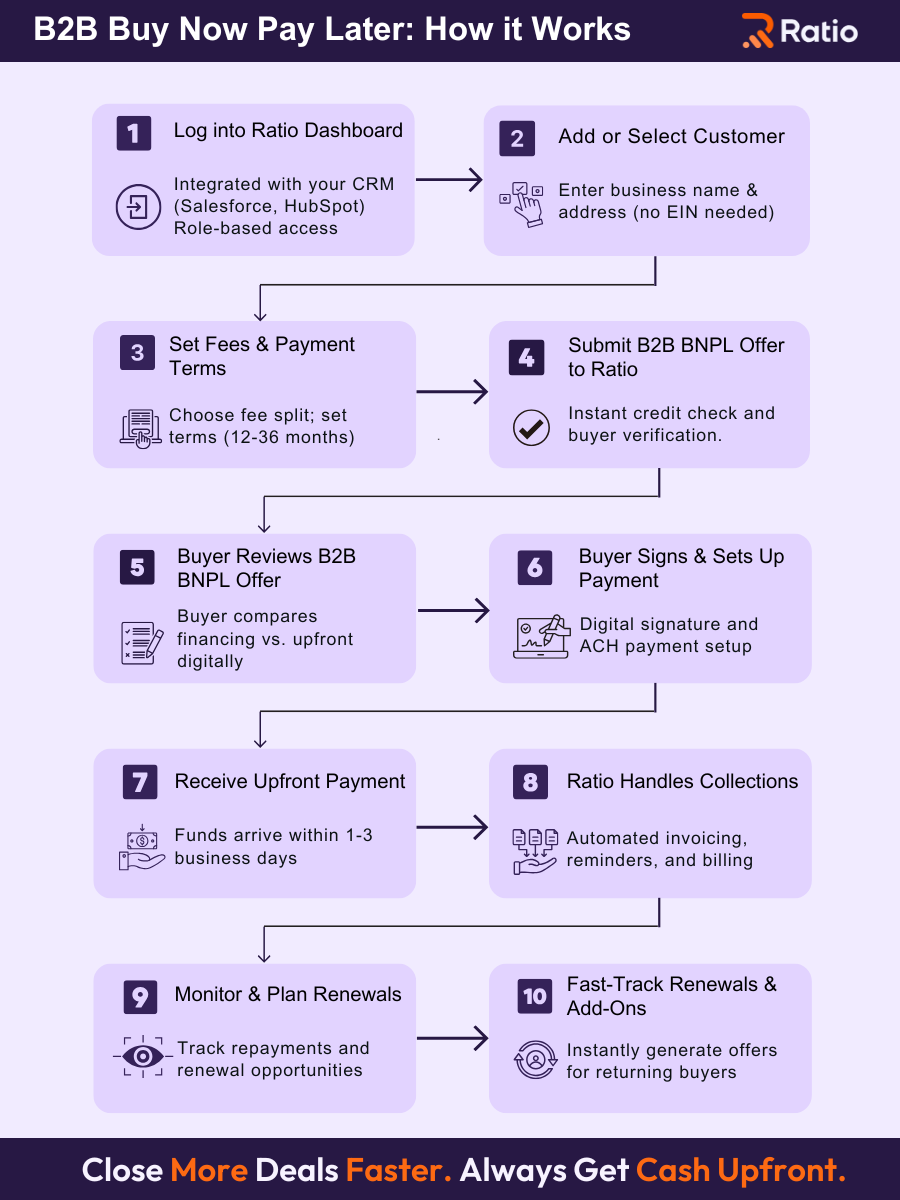
⚠️Limitations
- Buyer eligibility matters
If a buyer is too early, underfunded, or flagged as risky, they may not qualify. Keep fallback terms ready. - Requires light DevOps or RevOps setup
While integrations are pre-built, embedded financing still requires implementation inside your CRM or CPQ—especially if you're customizing workflows or terms.
#2. Contract-Based Advances
Contract-Based Advance is a non-dilutive funding model where B2B SaaS companies receive upfront cash based on signed revenue contracts, even if billing is deferred.
Unlike traditional loans (based on credit) or RBF (based on past revenue), this funding is tied to the strength of future booked revenue—turning bookings into working capital instantly.
📌 Example: You close a $200K, two-year SaaS contract with a Fortune 500 client, billed annually. A provider like Ratio Trade wires you up to $180K (90%) upfront, based on the signed agreement—no waiting for billing or payment to start.
🚀How It Supports SaaS Scaling
- 💸 Turn bookings into capital—instantly
Helps you monetize future revenue the moment a deal is signed. That means more cash on hand to fund sales, hiring, onboarding, or CAC-intensive channels.
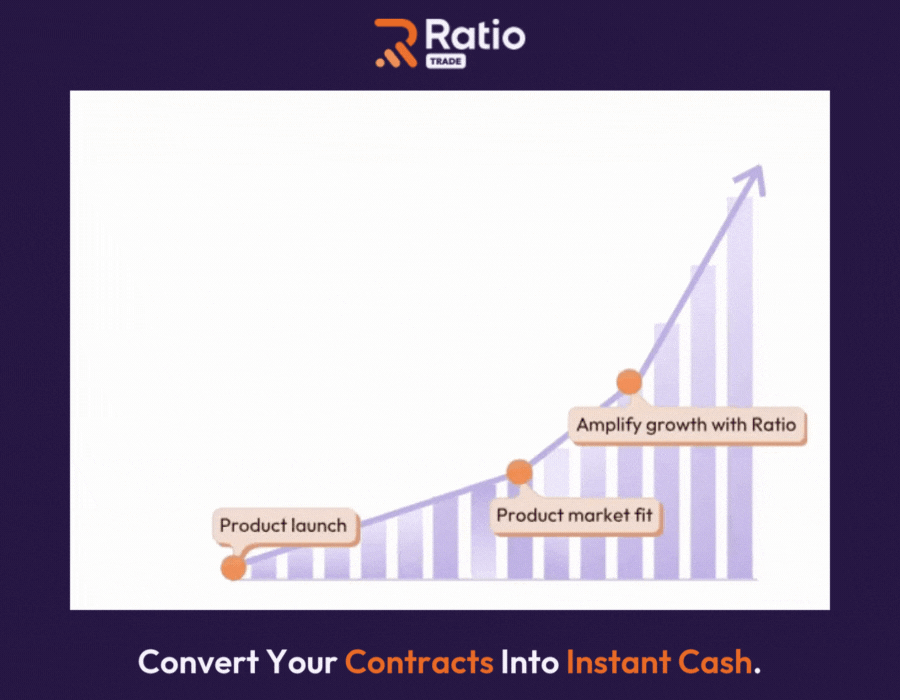
- 📈 Perfect for long-term or enterprise deals
Many buyers demand annual or multi-year terms with delayed payment (Net-60, Net-90). Contract advances convert those deals into liquidity—without requiring buyers to change terms. - 🧾 No need to change billing or pricing model
Unlike prepayment incentives or discounting, you keep your standard contract structure. That preserves margin and pricing discipline while still accessing immediate capital. - ⚙️ Less risky than debt, more predictable than RBF
You don’t owe any fixed payment. Repayment happens when the buyer pays their invoice.
🔍How to Access It
Key providers include Ratio Trade, Capchase, and Founderpath (in specific structures). Here’s what accessing it usually involves:
- Signed contract or billing agreement in place (ideally with a high-credit buyer)
- Contract submitted for underwriting (provider evaluates the size, term, and creditworthiness of the buyer)
- Advance offered (typically 85–95% of contract value)
- You will receive funds within 2–5 business days
- Repayment happens when the buyer pays the invoice, routed through the provider, or collected as agreed
👉 Want to see what your signed contracts are worth upfront? Use the Ratio Cash Flow Simulator to estimate your cash conversion instantly—no forms, no follow-ups.
⚠️Limitations
- Only applies to signed contracts
No pipeline monetization—only works once deals are closed and contracts executed. - Depends heavily on buyer credit
If your customer has poor credit or isn’t enterprise-grade, approval may be delayed or reduced. - Fees vary by risk and term
Expect 3–10% fees depending on contract size, term length, and buyer profile. - Not helpful for usage-based models
Harder to use if revenue is variable or milestone-based; best suited for fixed contracts with known cash flow.
#3. Revenue-Based Financing (RBF)
Revenue-Based Financing (RBF) offers non-dilutive capital in exchange for a percentage of future monthly revenue—making it a fast, flexible funding option for B2B SaaS companies with strong recurring revenue.
Instead of taking on fixed loan payments or giving up equity, companies agree to repay a multiple of the advances (e.g., 1.4x) over time through variable monthly deductions.
🚀How It Supports SaaS Scaling
RBF becomes powerful when paired with high-margin growth channels and strong MRR predictability:
- 💸 Access non-dilutive capital without giving up ownership
Get a $500K–$3M capital infusion to fuel CAC-heavy GTM, sales hiring, or product expansion—with zero equity dilution or board loss. - 📊 Align repayment with revenue
Payments scale with cash inflow—less in slower months, more in strong ones. That gives founders financial flexibility when markets shift. - 📈 Ideal for short-payback growth loops
If your CAC payback is <12 months, RBF lets you double down on what’s already working—then recycle returns into future cycles. - ⚙️ Faster than equity, friendlier than bank debt
No lengthy diligence. No fixed schedules. If you’ve got 12+ months of clean MRR data, most RBF providers can underwrite and disburse funds in under 10 days.
🔍How to Access It
Key providers include Pipe, Capchase, Founderpath, Arc, and Wayflyer (some focused on eCom + SaaS). If you’re weighing options, compare venture debt vs. revenue-based financing to choose the right fit.
To qualify sellers for the funding, most providers look for:
- U.S. entity with a predictable SaaS model (monthly/annual subscriptions) and 6 months of available revenue.
- 12+ months of recurring revenue (usually $1M+ ARR)
- Clean accounting data from platforms like Stripe, QuickBooks, or Chargebee
- Healthy gross margins (40–80%) and reasonable burn
Here is how it works in practice:
- Connect billing and financial systems via secure APIs.
- Provider analyzes historical revenue trends and churn.
- You’re offered an advance (e.g., $100K) repaid via 5–10% of monthly revenue.
- You repay until the cap is reached (e.g., 1.4x = $140K).
⚠️Limitations
- True cost can be steep
That repayment cap is fixed and often translates to a 30–40% effective Annual Percentage Rate (APR). Especially if you repay early, the cost-per-month skyrockets. - Repayments can erode reinvestment capacity
Giving up 5–10% of your top-line revenue during a rapid scale phase means less net cash to fund future growth—especially if you layer it with other obligations. - Mismatch with long-payback initiatives
RBF works best for short-ROI projects. Using it for R&D, infrastructure, or enterprise GTM (where returns lag 12+ months) can backfire. - Stresses when stacked
If combined with AR factoring, venture debt, or MCAs, multiple repayments can create revenue “slicing” that destabilizes ops.
#4. SaaS-Specific Term Loans (via Fintech Lenders)
SaaS-specific term loans are structured debt products designed specifically for subscription-based companies. Unlike traditional bank loans, these are offered by fintech lenders who understand SaaS business models—recurring revenue, customer churn, deferred cash collection, and high CAC dynamics.
Instead of focusing on Generally Accepted Accounting Principles (GAAP) profitability or hard assets, lenders underwrite based on net retention, MRR, burn multiple, and cash runway.
📌 Example: A growth-stage SaaS company with $3M ARR and 80% gross margin qualifies for a $1M loan, repayable over 24 months with a 12% interest rate. Funds land in 5–10 days and can be used for sales hiring, GTM, or Mergers and Acquisitions (M&A).
🚀How It Supports SaaS Scaling
- 💸 Accelerate growth with predictable capital
Deploy upfront capital into GTM, onboarding or incentivise sale reps, and expansion initiatives without waiting for customer collections or a VC round. - 📈 Align financing with your revenue engine
Designed for companies with reliable MRR and strong net retention—offering better terms than general-purpose loans or credit lines. - ⚙️ Maintain full equity control
It’s non-dilutive. You retain board control, cap table integrity, and full upside from your growth investments. - ⏱️ Act on growth windows quickly
Because underwriting is SaaS-specific (often API-based), approvals are faster than banks and less invasive than equity raises.
🔍How to Access It
Key fintech lenders in this space include Boopos, Founderpath, Element Finance, etc.
To qualify, most providers look for:
- $2M–$20M ARR, with stable monthly growth
- US-based C-corp or similar structure
- Historical billing and accounting data (via platforms like Stripe, QuickBooks, or Chargebee)
- Gross margin >60%, burn multiple <2.5
Here’s how it works in practice:
- Connect your financial systems securely via API.
- Submit key metrics: MRR trends, burn, customer retention, etc.
- Receive a loan offer based on ARR and repayment ability.
- Choose term length (usually 12–36 months).
- Receive funds in 5–10 business days.
⚠️Limitations
- High interest rates vs. traditional debt
Fintech lenders charge more than banks—APR often ranges from 12–30%, depending on the term and risk profile. - Fixed monthly repayments regardless of revenue
Unlike RBF, you owe the same amount every month—even during slow seasons or unexpected churn. - Covenants and restrictions may apply
Some loans include covenants like minimum liquidity thresholds, revenue floors, or limitations on future debt. - Can strain cash flow if not precisely timed
If CAC payback is long or growth is lumpy, fixed repayments may outpace revenue inflows—creating pressure on operations.
You’ve seen how the best SaaS financing options compare—each with unique strengths, operational implications, and trade-offs. But if you’re a B2B founder aiming to shorten sales cycles, protect margins, and scale without debt or dilution, there’s one model built specifically for that: Q2C with embedded financing.
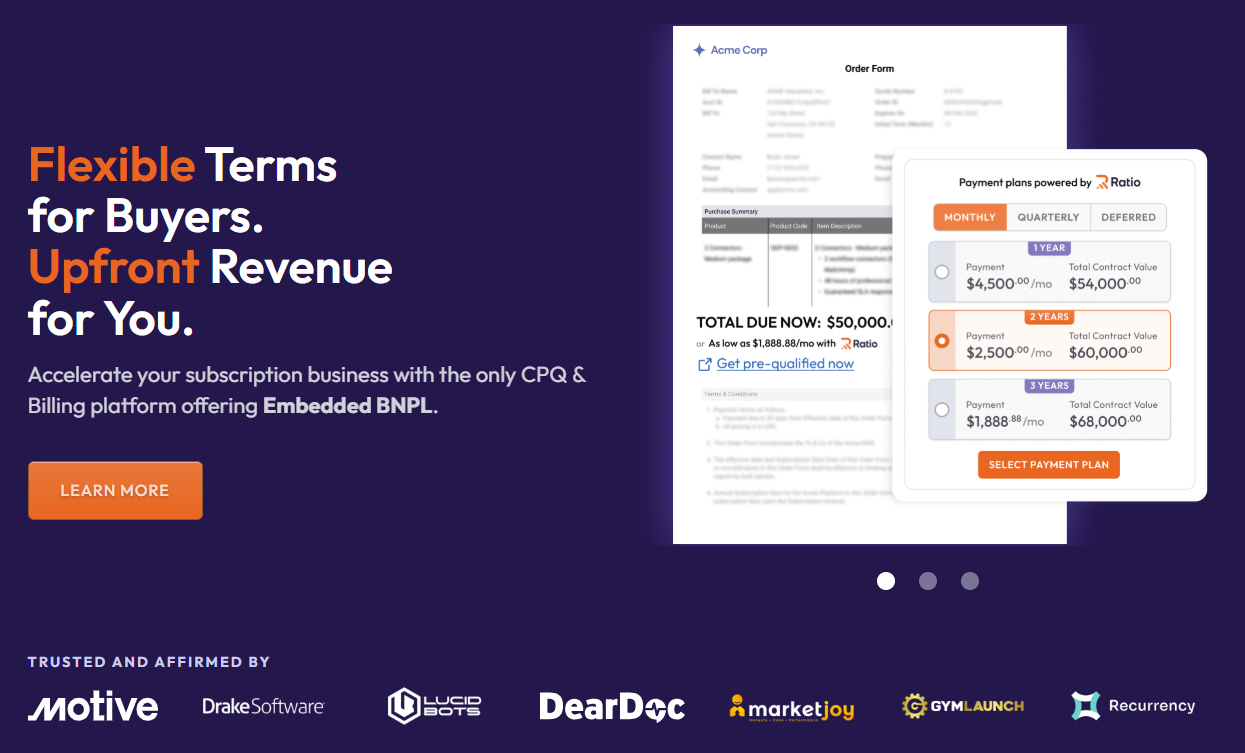
At the forefront of this shift is Ratio Boost—a purpose-built platform that turns annual contracts into upfront capital embedded directly into your sales motion.
Wait, you’ve got to see this 👇 Here’s why more B2B founders are choosing Ratio Boost to fund growth.
Why B2B Founders Choose Ratio Boost for SaaS Financing That Actually Scales Growth
First, hear it from Kyle Dou, Founder & CEO of Tuff Robotics:
“We’re a startup who helps companies with labor challenges. With Ratio, our customers are able to onboard online and get approved almost immediately. Boost was easy to implement and has helped us grow tremendously.”
And Kyle’s not alone. Richard Whalen, Head of Finance at Brainshark, shared a similar experience:
“With Ratio, we can now leverage our recurring revenues to fuel our growth, optimize cash flow, and improve sales conversion—all without dilution.”
These founders didn’t just offer their buyers more payment flexibility. They unlocked capital—instantly—to grow on their own terms.
As now they can reinvest faster—into GTM, sales hiring, onboarding, expansion—without touching equity or taking on debt.
Here’s what makes Ratio Boost the SaaS financing strategy built for scale:
💰 $411M+ funding pool ready to deploy
🤖 Real-time AI underwriting for instant buyer approvals
🔗 CRM + CPQ integrations to keep your quote flow friction-free

You don’t chase payments. You don’t rewrite contracts. You just close, collect, and compound—on your terms. That’s why more B2B founders are choosing Ratio Boost
👉 So hurry and [Book a Demo] to see how Ratio Boost fits your sales motion.
Disclaimer: The information shared is for general guidance only. Terms, eligibility, and funding structures vary by provider and business profile. This does not constitute financial advice or a lending offer. Always consult your finance team and review provider terms before making funding decisions.
FAQs
1. How Can I Get Non-Dilutive SaaS Financing?
Start by identifying what kind of cash flow you can unlock: signed contracts (contract advances), closed deals (BNPL), or historical revenue (RBF). Then, choose a provider that integrates with your systems (CRM, billing, accounting), offers flexible terms, and aligns with your scale stage. Platforms like Ratio can approve and fund qualified deals in days—with no equity dilution, personal guarantees, or fixed repayments.
You can also refer to The Entrepreneur's Roadmap to Acquiring Non-Dilutive Funding
2. Is SaaS Financing Only for Companies With Recurring Revenue?
Not necessarily. While many financing models are optimized for MRR/ARR, tools like contract-based advances and Q2C with embedded financing can work for milestone or term-based revenue—especially if you’re selling multi-year or annual contracts.
What matters most is the predictability, quality of your cash flows and more that you can discover in our guide for Understanding Recurring Revenue Financing
3. Will Financing Impact My Customer Experience or Billing Operations?
Only if the provider’s workflows are poorly integrated. With embedded solutions like Ratio Boost, flexible payment terms are offered inside your quote—no billing changes, no operational friction. Customers enjoy more options; your team keeps control. The best solutions feel native to your existing sales motion and CRM.
4. Can I Use Multiple SaaS Financing Tools Together?
Yes—but carefully. For example, you might use embedded financing to accelerate cash from closed deals and RBF to scale CAC-heavy growth loops. That said, stacking too many instruments can fragment your cash flow and complicate forecasting. Always model combined repayments and monitor margin pressure with our funding comparison calculator. Smart layering, not over-leveraging, is key.
5. When Is It Better to Raise Equity Instead of Using SaaS Financing?
SaaS financing is ideal when you have predictable cash flows and a clear growth loop. But if you're building new product lines, investing in long-term R&D, or entering markets with long payback cycles—equity might be a better fit. Use non-dilutive capital for repeatable scale, and reserve equity for strategic bets.







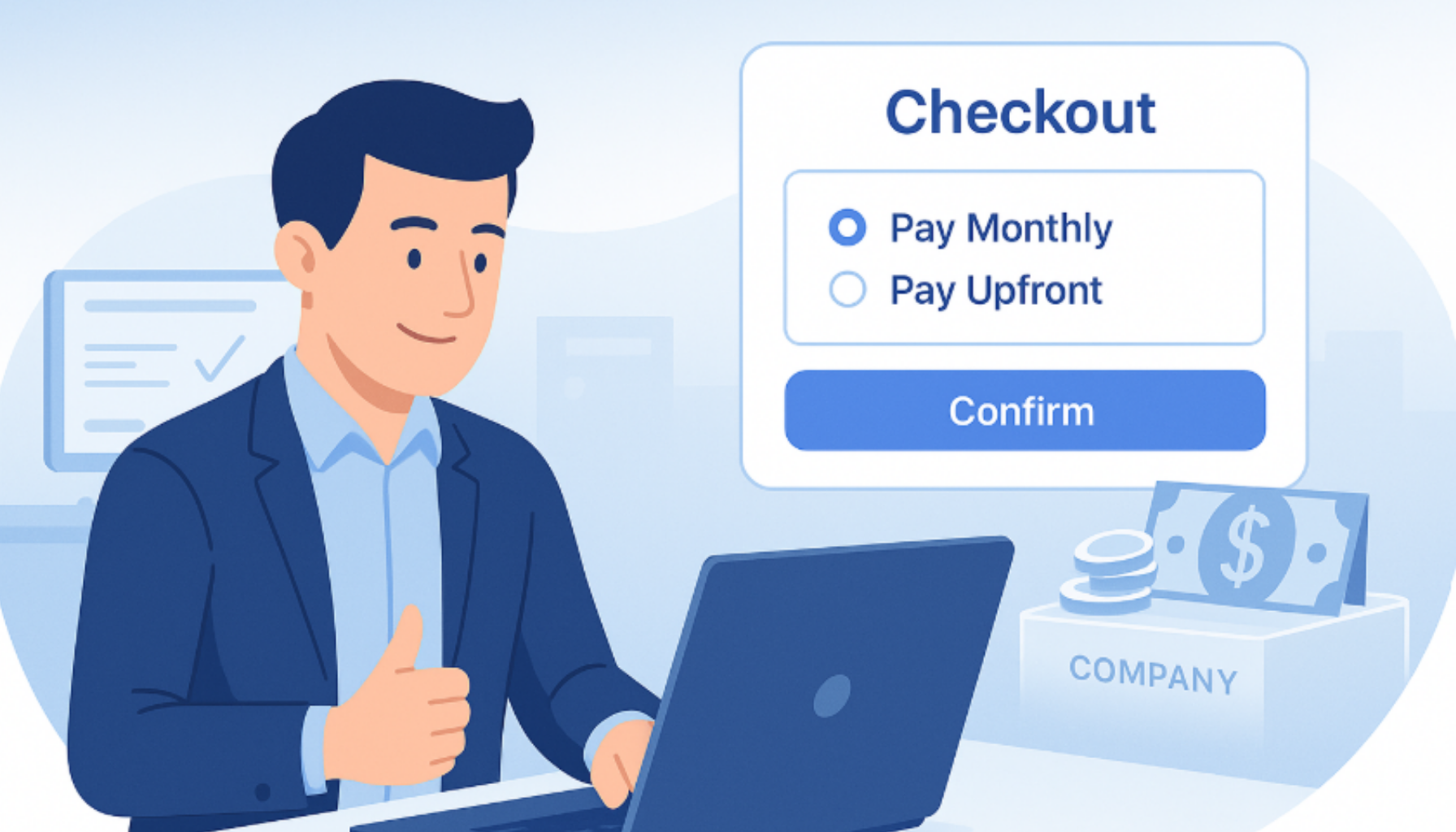
.png)



